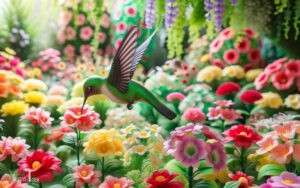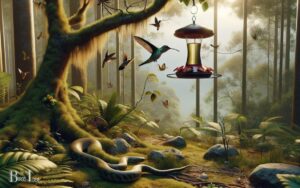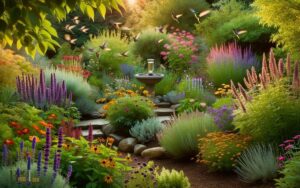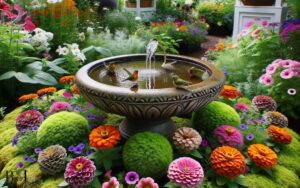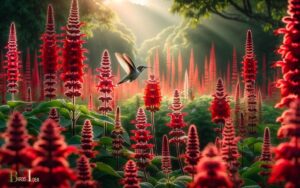How to Attract Hummingbirds in Wisconsin? Explore!
To attract hummingbirds in Wisconsin, you can create a hospitable environment by planting native flowers that produce nectar, such as bee balm, columbine, and jewelweed.
Installing a hummingbird feeder with a sugar-water mixture (four parts water to one part white sugar), avoiding red dye, and cleaning the feeder regularly can also entice these birds.
Providing perches, shelter, and avoiding pesticides will make your garden more appealing to hummingbirds.
Hummingbird feeders are an additional resource, especially during migration when natural food may be scarce. It’s important to maintain a clean feeder to prevent the spread of disease among birds.
Perches offer resting spots, while avoiding pesticides ensures a safe habitat for hummingbirds and their insect prey.
Example of plants to attract hummingbirds in Wisconsin:
Creating a hummingbird-friendly garden in Wisconsin can transform your outdoor space into a vibrant and lively sanctuary, buzzing with the delightful activity of these small, energetic birds.
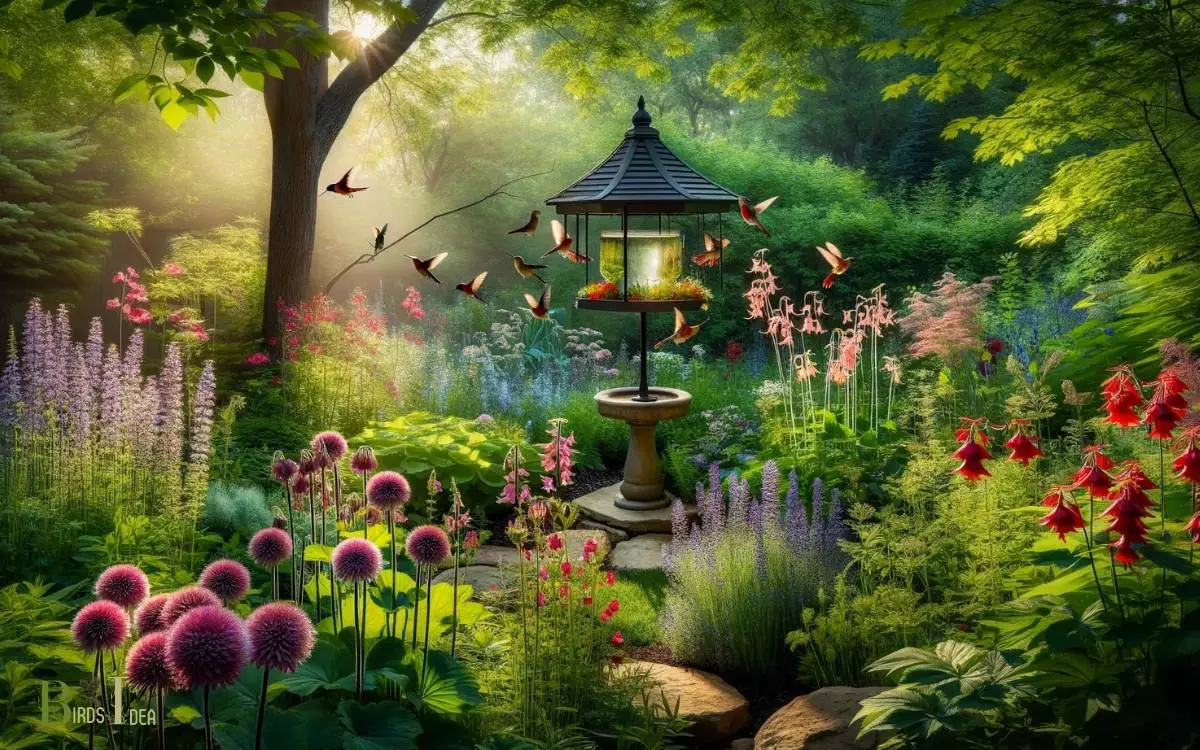
Key Takeaway
Understanding Hummingbird Behavior
Hummingbirds exhibit intricate and fascinating behaviors during their migratory and breeding seasons in Wisconsin.
These tiny creatures are known for their remarkable agility and speed, capable of flying up to 30 miles per hour and changing direction in an instant. During migration, they cover thousands of miles, navigating their way with precision.
In Wisconsin, they arrive in late April and depart in September, making the most of the warm months.
Understanding their behavior is crucial to attracting them to your garden. They are drawn to brightly colored flowers with tubular shapes, as these provide the nectar they need to fuel their high-energy lifestyle.
By selecting native plants and flowers that cater to their preferences, you can create an inviting environment that encourages these delightful birds to visit regularly.
Selecting Native Plants and Flowers
Selecting native plants and flowers that bloom throughout the hummingbird season is essential for creating a vibrant and enticing habitat.
In Wisconsin, some excellent native plant choices include trumpet vine, bee balm, cardinal flower, and red columbine. These plants provide nectar that hummingbirds love and are well-adapted to the local climate and soil conditions.
When choosing flowers, opt for tubular-shaped blooms in shades of red, orange, and pink, as these colors attract hummingbirds the most. It’s also important to select a variety of plants with staggered bloom times to ensure a constant nectar supply.
By incorporating these native plants and flowers into the garden, individuals can create an inviting environment that sustains and attracts hummingbirds throughout their active season.
Setting Up Hummingbird Feeders
The establishment of hummingbird feeders is crucial for providing supplemental nectar and attracting these tiny birds to the garden.
To set up hummingbird feeders effectively, one should consider the following:
- Placement: Hang the feeders in a shaded area to prevent the nectar from spoiling too quickly in the sun. This also provides a safe and comfortable environment for the hummingbirds to feed.
- Maintenance: Regularly clean and refill the feeders with fresh nectar to ensure the health of the visiting hummingbirds and prevent the growth of mold or bacteria.
- Type of Feeder: Choose a feeder with bright red parts to attract hummingbirds and make sure it has perches for the birds to rest while feeding.
Creating a Hummingbird-Friendly Environment
To create a hummingbird-friendly environment in Wisconsin, gardeners can incorporate native flowers and plants that provide nectar and perches for the birds.
Native wildflowers such as bee balm, trumpet vine, and cardinal flower are excellent choices for attracting hummingbirds. These plants not only offer nectar as a food source but also provide sturdy perches for the birds to rest and observe their surroundings.
Additionally, incorporating a variety of flower colors and shapes can further attract hummingbirds to the garden. It’s important to choose plants that bloom at different times throughout the growing season to ensure a consistent nectar supply.
By creating a diverse and abundant landscape with native flora, gardeners can significantly increase the likelihood of attracting and supporting hummingbirds in their Wisconsin gardens.
Maintaining a Safe and Healthy Habitat
Maintaining a healthy habitat for hummingbirds in Wisconsin requires regular cleaning and upkeep of feeders and the removal of any potential hazards such as toxic plants or pesticides.
To ensure a safe and healthy environment for these delicate birds, individuals can follow these guidelines:
- Regular Feeder Cleaning: Clean feeders with a solution of one-part white vinegar to four parts water at least once a week to prevent mold and bacteria growth.
- Plant Selection: Choose native plants that are safe for hummingbirds and avoid toxic varieties such as azaleas, rhododendrons, and foxglove.
- Pesticide-Free Zones: Refrain from using pesticides and herbicides near hummingbird feeders or plants to prevent accidental harm to the birds.
Conclusion
Attracting hummingbirds in Wisconsin is a rewarding and enjoyable experience. While some may worry about the time and effort involved, the joy of watching these beautiful birds fluttering around your garden is well worth it.
By following the tips in this article, anyone can create a welcoming environment for hummingbirds to thrive and bring a touch of natural beauty to their backyard.

